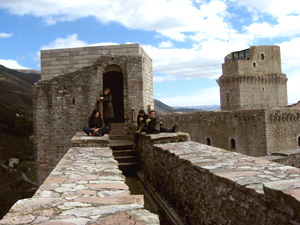
On Wednesday, 12 of March, after two roaring days in Florence, we split into three groups for day trips to Siena, Pisa and Assisi, with ECLA professors as our guides.
The trip to Assisi had something of a pilgrimage about it as we set off early in the morning. Once we arrived in the small Umbrian town of Saint Francis, we found ourselves climbing a soft path up to the monastery. We went to Florence with the curious eyes of those who, after nine weeks of studying, want finally to see what we had seen only in pictures. In this sense, Assisi also offered space for reflection and contemplation surrounded by nature instead of the noisy touristic groups in Florence. We took it as a good sign that it was the first sunny day after the previous days’ rain.
ECLA professor Tracy Colony spoke about the emergence of monastic orders in the Middle Ages before entering the monastery, so that we could maintain silence and view the frescoes at our own pace once inside. The Franciscans emerged as a mendicant order between 1210 and 1215 during the pontificate of Innocent III. At this time the Roman Catholic Church was accumulating substantial wealth, necessitating an ideological accommodation. Along with the Dominicans, an order established a few years previously, the Franciscans embraced the ideas of poverty and of giving up material possessions in order to be closer to Christ’s own way of living.
From outside, the monastery seems imposing but peaceful, and something about its setting makes people walk slowly up the hill to its entrance. The building of the monastery was begun after the canonization of Francis of Assisi in 1228 and completed almost twenty years later. The monastery is divided into an upper and a lower church, the lower church containing the saint’s relics and tomb, exposed for veneration. The tomb generated different reactions among students, some considering it rather ostentatious for a saint who all his life preached poverty and abstention and who, on those principles, founded a monastic order. However, we also considered the difficulty of preserving the memory of a saint with proper dignity. Inside the church we studied Giotto’s frescoes depicting the life of Saint Francis, occasionally whispering our thoughts and impressions. Beside the Giotto frescoes, there are wall paintings of Old and New Testament scenes by Cimabue, Pietro Cavallini and others.
The following day in Florence retained something of the peaceful mood of the trip to Assisi. San Marco is a Dominican monastery, in which the monks’ small cells are each adorned with a fresco by Fra Angelico. A monk in Fiesole, Fra Angelico moved to the newly built monastery of San Marco as early as 1436 and commenced work on the frescoes at Cosimo de Medici’s request. Intended as devotional aids depicting scenes from the life of Christ and painted in a modest palette, the San Marco frescoes inspire a feeling of humility and piety.
Viewing the Annunciation scene at San Marco, situated on the wall that confronts the visitor on entering the monastery, one senses the delicacy of Angelico’s painting, the gentleness of shapes, heavier and stiffer in other depictions (for example, Giotto’s Annunciation painting in the Arena Chapel at Padua), the simplicity of the interior and the care and detail in the surrounding nature within the fresco. Walking through the hallways of the San Marco monastery, and entering the small cells there, also gave us a keen understanding of the nature of the Dominican belief in the need for poverty and seclusion. With only a small window overlooking interior garden of the monastery, the monks would dedicate their time to prayer before the frescoes of Fra Angelico.
In these days spent in Assisi and in Florence we experienced two monastic orders in different ways and in different moments. As well as seeing the Giotto and Fra Angelico frescoes in each of the two monasteries, we came across the Franciscan monks walking the narrow streets of Assisi; and, although with a different eye, we also got a feeling of the Dominicans’ day-to-day life, entering their cells in San Marco and seeing, perhaps, just a little, as they saw.
by Livia Marinescu (2008, Romania)
